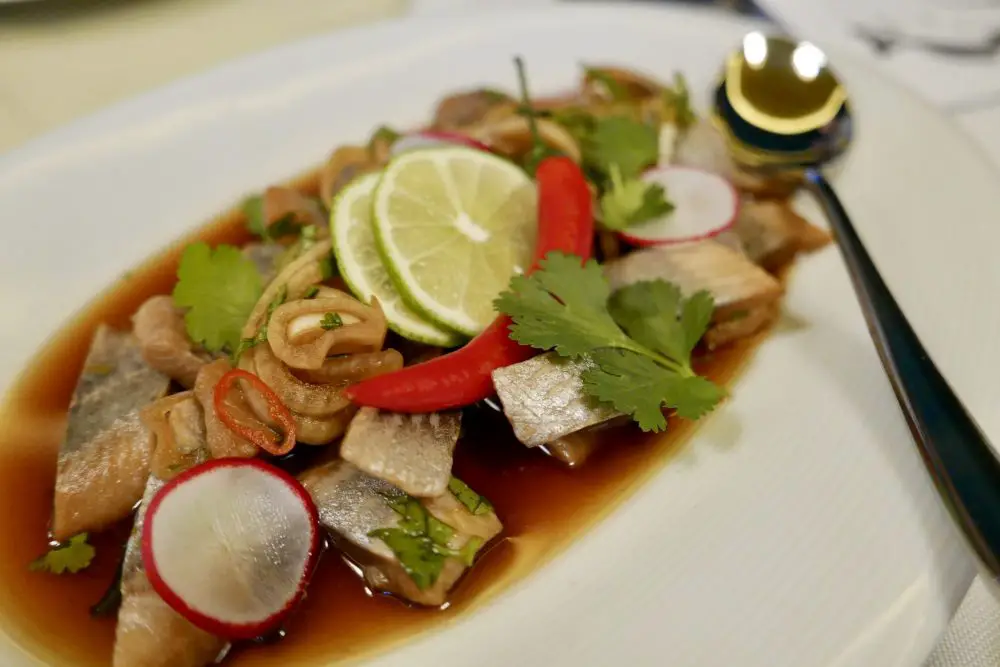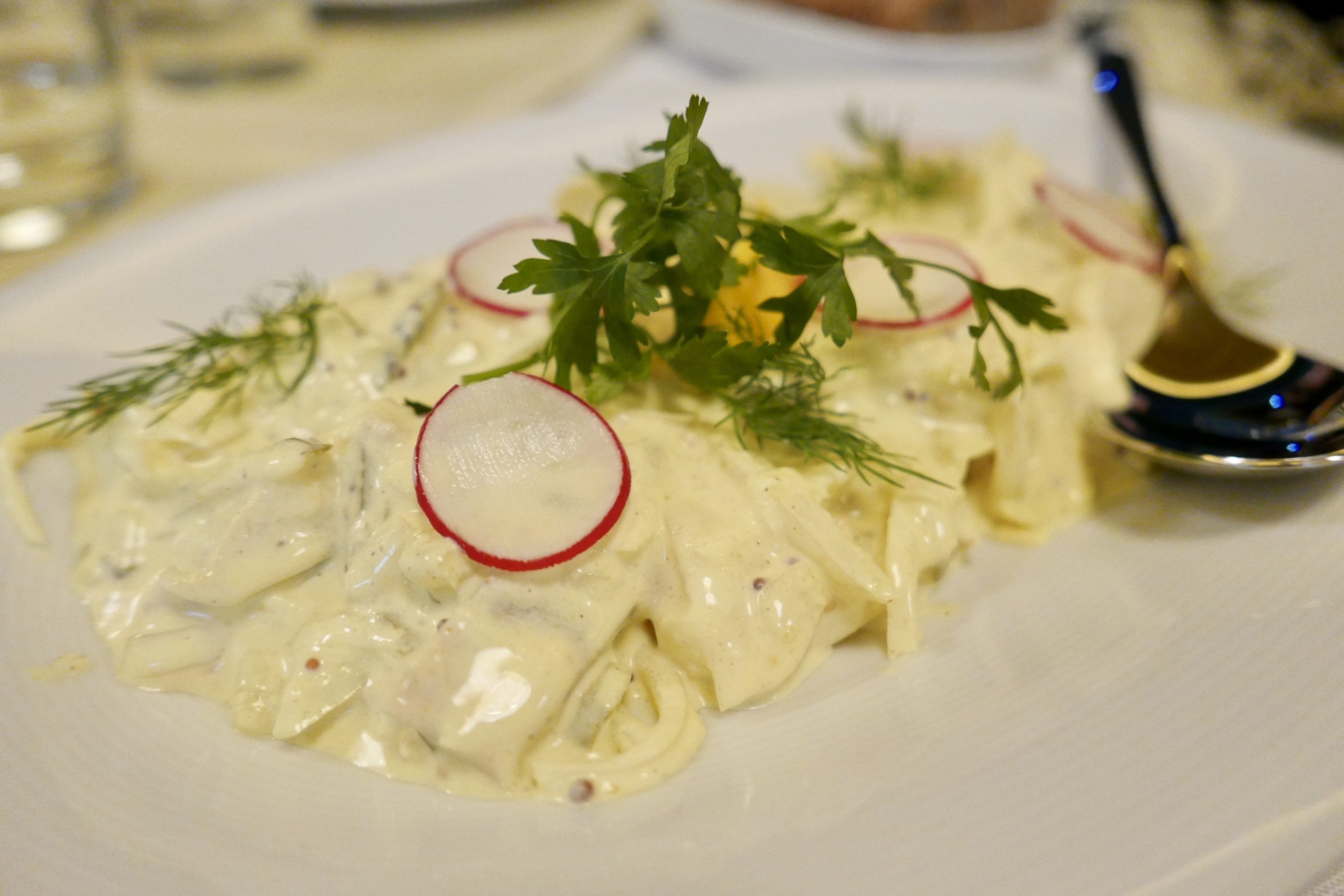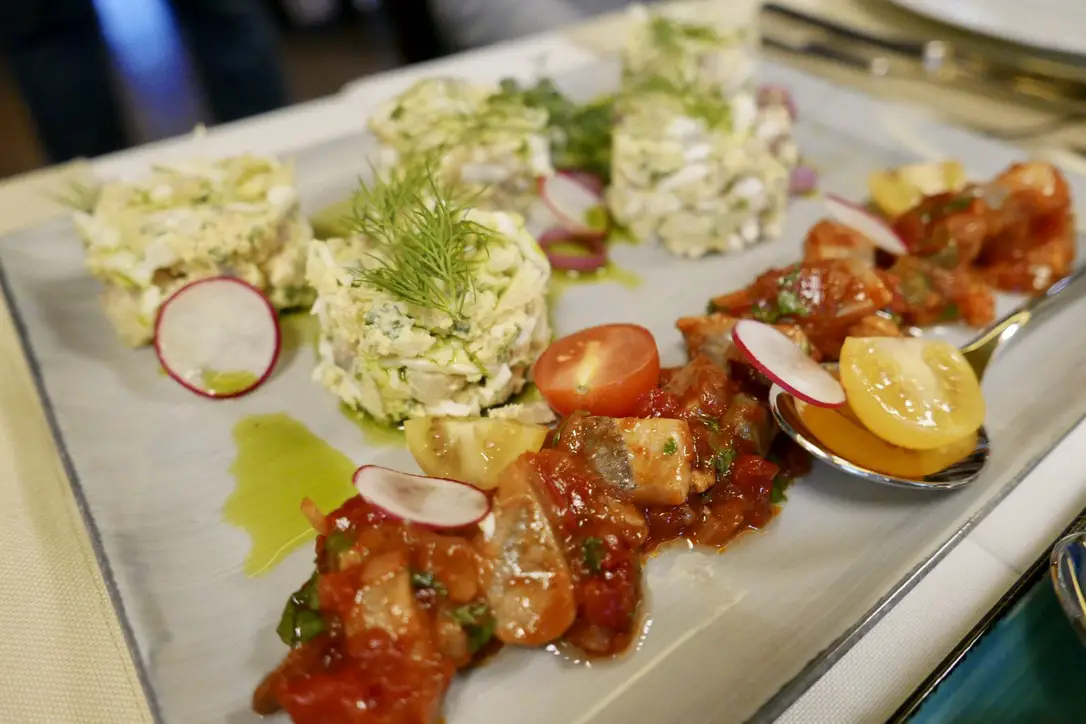
The name directly translates to ‘under the salmon’ and there is indeed a salmon carved over the main entrance. We were there to celebrate Polish fish dishes and a good proportion of those were herring based!

Pod Łososiem is a very impressive space and I was lucky to be part of the first group to eat there since their stunning renovation project. The space is beautiful with many original features paired to with soft dark teal tones and modern, comfortable seating. Looking on Google, it was pretty gothic inside but now, it feels transformed. The restaurant has been run by the same family since just after the Second World War and is situated in one of the few remaining original Old Town buildings in Gdansk. The building itself is as interesting as the restaurant too. It was formerly the Wasserhouse, the place where Goldwasser (a liqueur infused with flakes of gold) was first distilled, right back in the late 16th century.
We were lucky to be there not only as guests of Pod Łososiem but also to listen to local food critic Artur Michna tell us a little about the history of food in Gdansk, with a specific focus on fish – as you’d expect, being in a fish restaurant!


Back to the herring…
Herring (and fish in general) has a long tradition in Poland. It’s been part of Polish cuisine since the Middle Ages and there are literally thousands of ways to prepare and eat it, many of which are old recipes handed down through generations of grandmothers and mothers (and hopefully, sometimes fathers and grandfathers too). Historically, herring (often served with cabbage) was considered a pauper dish with other fish like carp, cod, zander and garfish being more popular with the wealthy. With a large Jewish community in Gdansk and Poland as a whole, fish was always eaten on a Friday in place of meat. Artur told us that there are recipes going back to the 17th century and they are almost always for pickled, salted and brined herring. Why? Likely because it spoils quickly and pickling is an easy low cost way of preserving the fish.
After hearing about the food history of Gdansk and particularly, the importance of the humble herring, we were lucky enough to try it in five different styles, spanning the historic through to the modern. My favourite was the asian influenced dish – with chilli, lime, soy, coriander and radish. Surprisingly, the strong flavour of the fish actually worked really well with the spice and kick of lime. We also tried it in its most typical form – with sour cream and sorrel, pickled with sweet and sour onions, with peppers and paprika in a tomato sauce (my second favourite) and in a salad with butter, onion and egg – kind of like a Russian salad.


Artur also brought along a very traditional recipe for Kashubian Herring (Gdansk is in the region of Kashubia) which I’m happy to share with you here. I warn you though!! Do not make the mistake I made and not read this through before you start. The process from start to finish will take four days. Start on a Thursday and you’ve got yourself a lovely Sunday brunch!
Kashubian Herring
Ingredients
- 500g herring, salted in brine – the recipe calls for bone in, skin on. This is hard to find in the UK and adds time and effort to the recipe, so use a jar of salted herring fillets in brine if preferred. You can find these at most Polish and Eastern European supermarkets!
For the marinade:
- 500 ml water
- 100 g caster sugar
- 200 ml vinegar
- 1 onion, sliced
- 2-3 bay leaves
- A few grains of all spice (or peppercorns if you don’t have this)
For the sauce:
- 6 tbsp 0il (vegetable, sunflower or rapeseed is best)
- 5 large onions diced
- 250 g plums, prunes or raisins
- 250 g sour cucumbers – this again, can be picked up from a Polish supermarket. Look for a big jar because they’re addictive as snacks!
- 3 tbsp tomato puree
- 2 bay leaves
- 1 tsp thyme or marjoram (dried is fine)
- Salt and pepper
Method
- Clean the herring, remove the bones and the skins, soak the fillets in water for two hours to flush out the excess salt. Drain. If you’re using a jar of pre-filleted herring, just drain the liquid and move onto the next stage.
- Boil the water with the sugar, remove from the heat, pour in the vinegar, add the sliced onions, bay leaves and all spice. Put the herring fillets into the marinade and store in the fridge for 2 days.
- For the sauce: Pour the oil into a large frying pan. Add the diced onions and cook until stewed but not browned. Add the plums (or raisins or prunes) to the pan. Cube the cucumbers and add to the pan. Add the herbs and the bay leaves. After a few minutes, add the tomato paste. Season to taste with salt and pepper.
- Cut the marinated herring fillets into smaller pieces and combine them with cold sauce. Store in the fridge for a further two days.
- Serve with rye bread and, if it takes your fancy, chilled vodka.
I was a guest of Pod Łososiem as part of a press trip, organised by KOWR (National Support Centre for Agriculture). I did not pay for my meal but was not expected to write a blog post about this specific experience. All opinions are my own.



My Family Loved it. I am definitely sharing Guys, Thanks For sharing this Great Recipe. this recipe and this website with my friend. Hope they also love it. Thank you again for sharing such a great recipe.